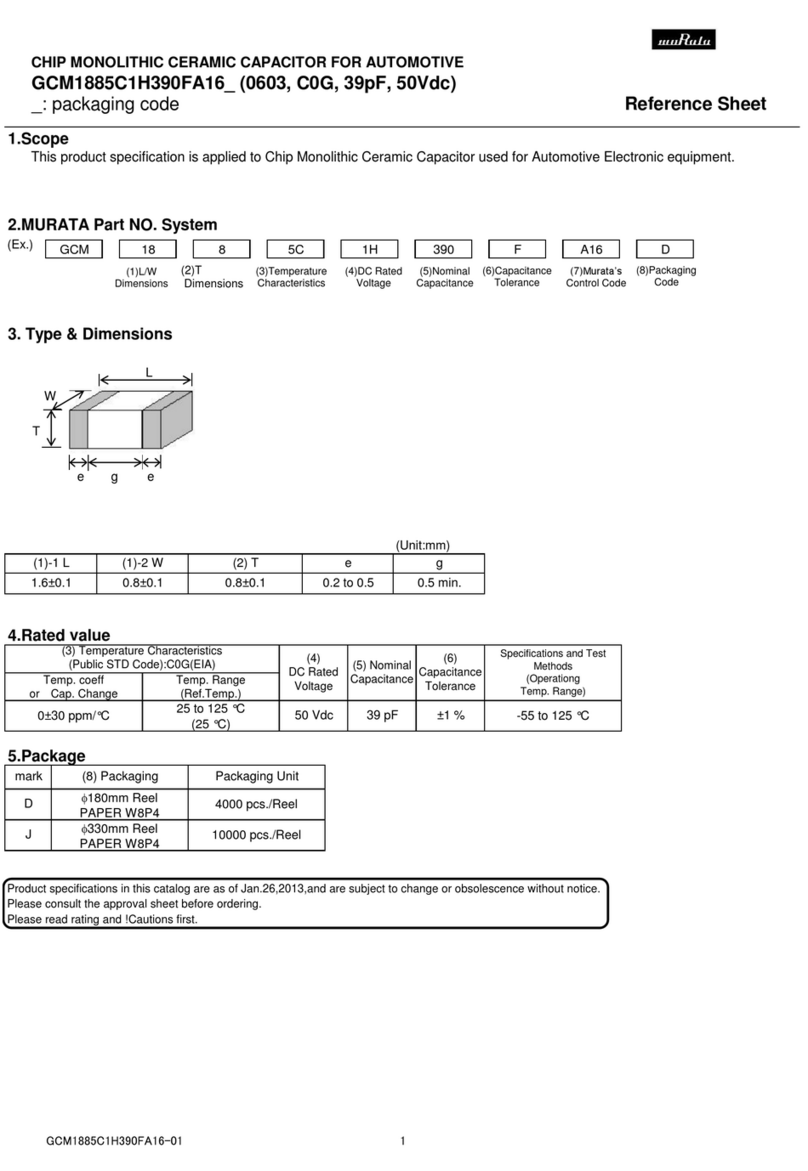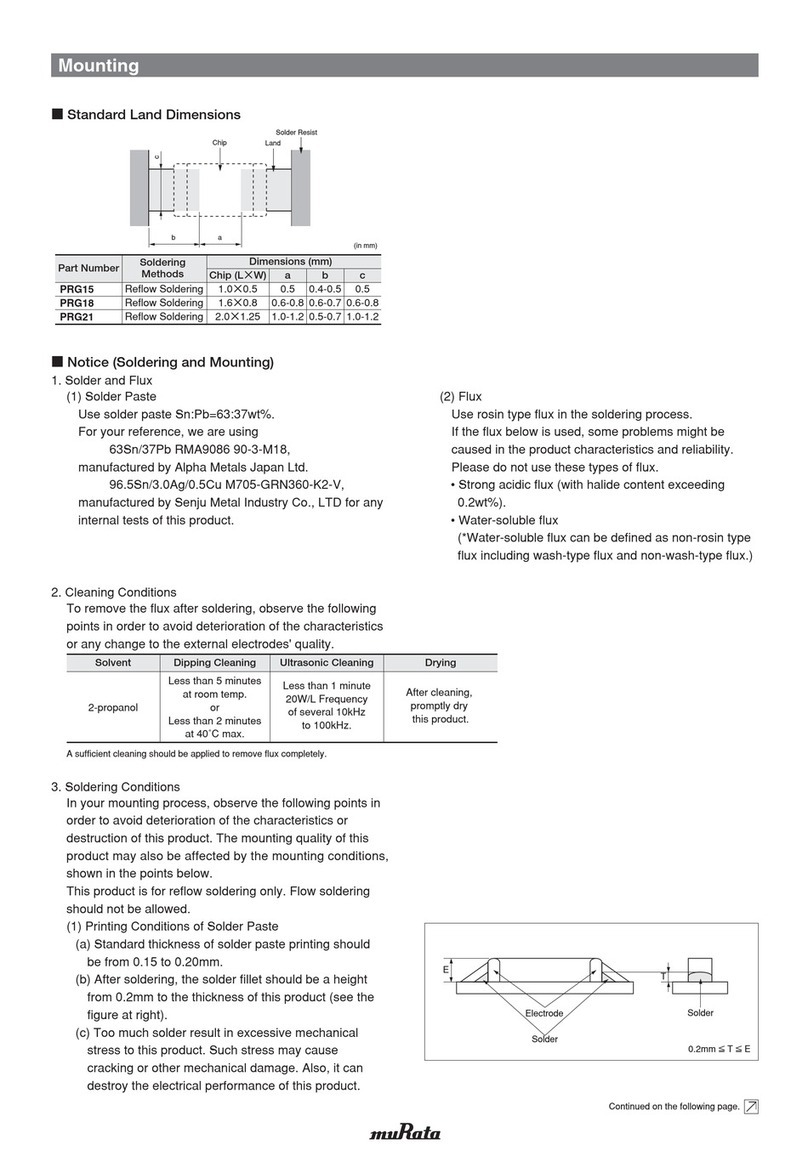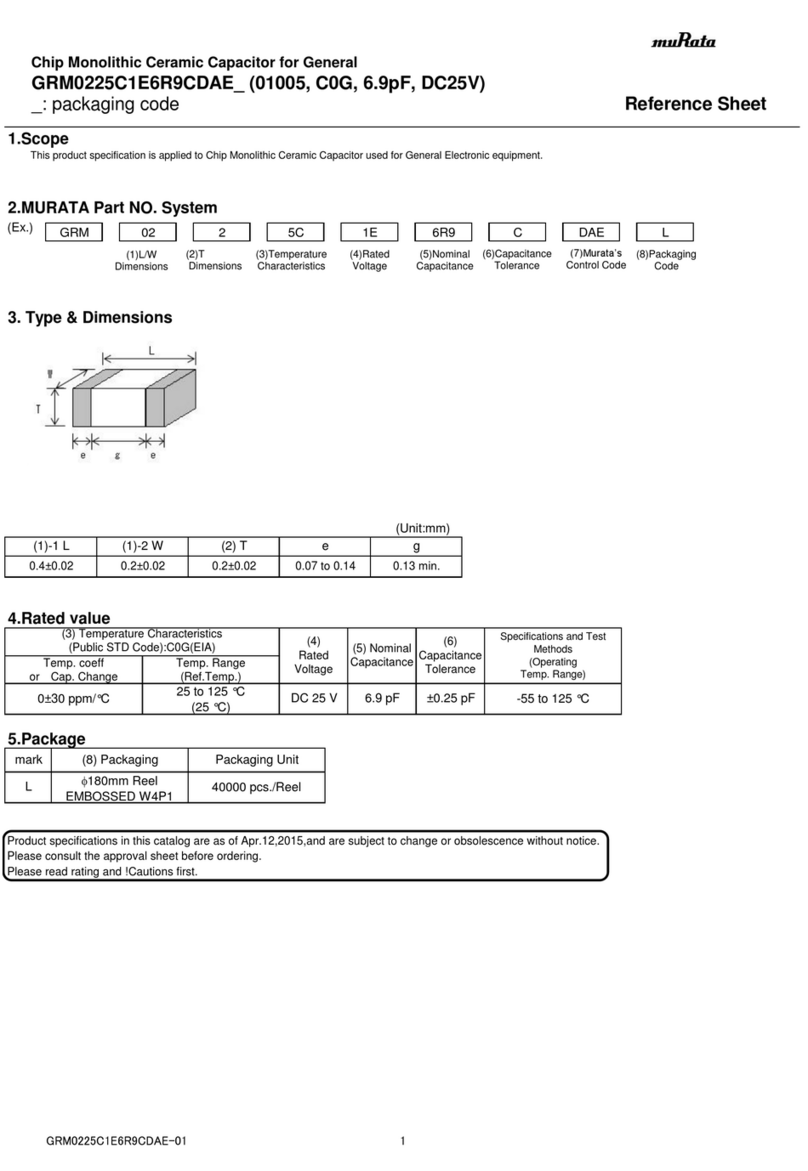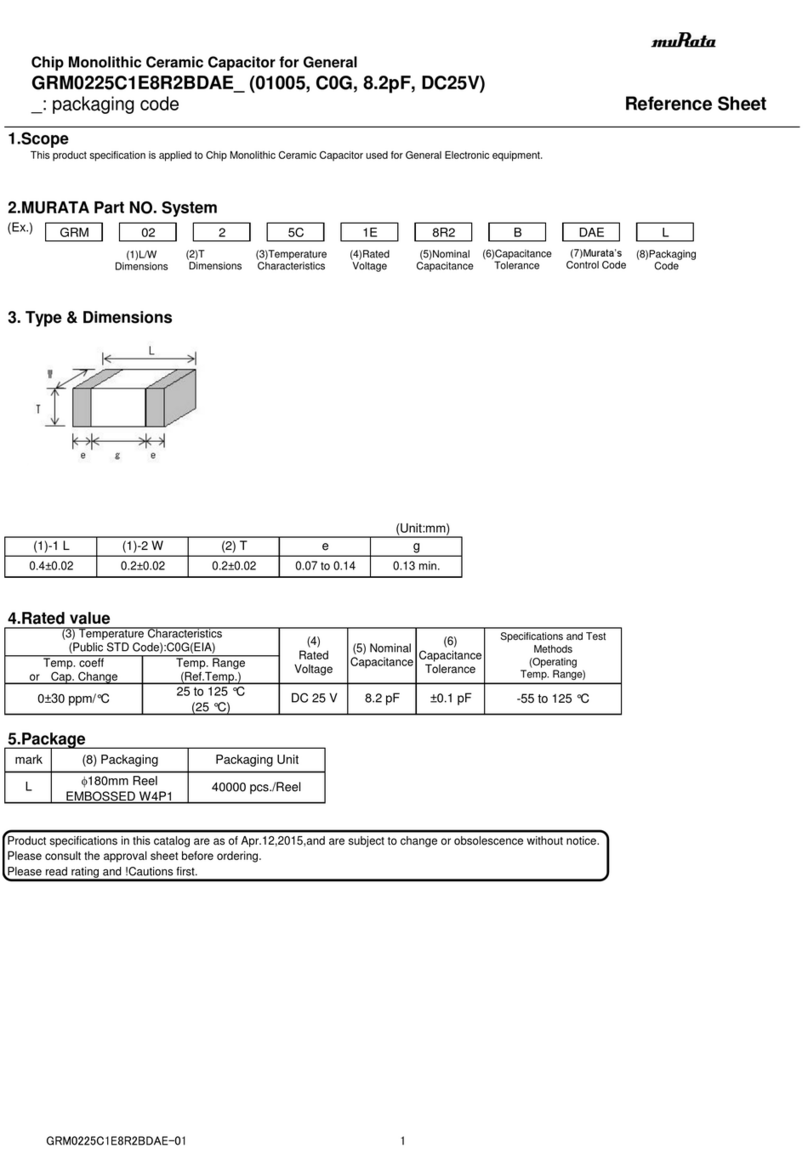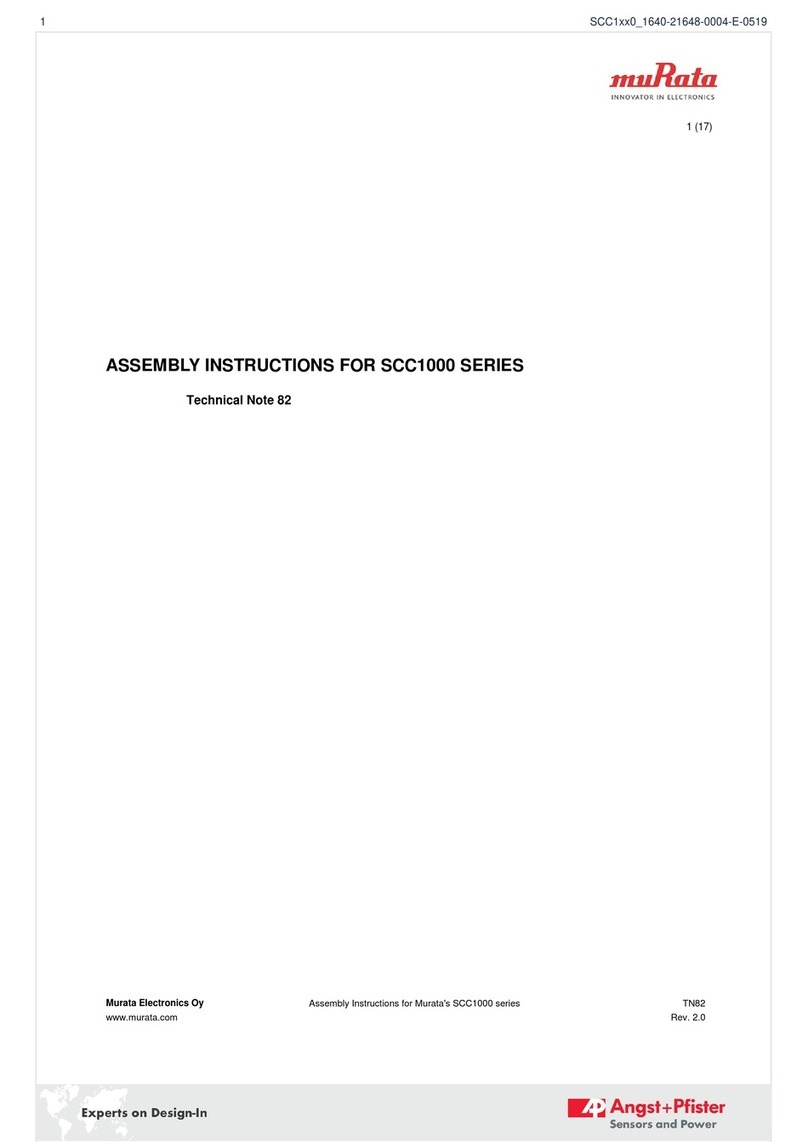
Temperature
Compensating Type
High Dielectric
Constant Type
11 Vibration Appearance No defects or abnormalities. Solder the capacitor on the test jig(glass epoxy board) shown in Fig.3
Resistance
Capacitance Within the specified tolerance. The capacitor should be subjected to a simple harmonic motion having
a total amplitude of 1.5mm, the frequency being varied uniformly between
Q/D.F. 30pF and over:Q≧1000 [R6,R7,C8,L8]the approximate limits of 10 and 55Hz.
30pF and beloow:Q≧400+20C W.V.:100V : 0.025max.(C<0.068mF) The frequencyrange, from 10 to 55Hz and return to 10Hz, should be
: 0.05max.(C≧0.068mF) traversed in approximately 1 minute. This motion should be applied for
C:Nominal Capacitance(pF) W.V.:50V/25V : 0.025max.
a period of 2 hours in each 3 mutuallyperpendicular directions
W.V.:6.3V/4V : 0.05max. (C<3.3mF)
[R9]
W.V.:50V : 0.05max.
[E4]
W.V.:25V : 0.025max.
[F5]
W.V.:25Vmin : 0.05max. (C<0.1mF)
W.V.:16V/10V : 0.125max.
W.V.:6.3V : 0.15max.
12 Deflection Appearance No defects or abnormalities.
Solder the capacitor on the test jig(glass epoxy board) shown in Fig.1
using an eutectic solder.
Within ±5% or± 0.5pF Within ±10% Then apply a force in the direction shown in Fig 2 for 5±1 seconds.
Change (Whichever is larger) The soldering should be done by the reflow method and should be
conducted with care so that the soldering is uniform and free of defects
such as heat shock.
13 Solderability 75% of the terminations is to be soldered evenly and continuously. Immerse the capacitor in a solution of ethanol (JIS-K-8101) and
of Termination rosin (JIS-K-5902) (25% rosin in weight proportion) .
Preheat at 80 to 120℃for 10 to 30 seconds.
After preheating , immerse in an eutectic solder solution for
2±0.5 seconds at 230±5℃or Sn-3.0Ag-0.5Cu solder solution
for 2±0.5 seconds at 245±5℃.
14 Resistance to The measured and observed characteristics should satisfy <GRM03 size min.>
Soldering Heat the specifications in the followingtable. Preheat the capacitor at 120 to 150℃for 1 min.(GRM31 size max.)
Preheat the capacitor at 100 to 120℃for 1 min and
Appearance No defects or abnormalities.
170 to 200℃for 1 min.(GRM32 size min.)
Within ±2.5% or±0.25pF R6,R7,R9,C8,L8 : Within ±7.5% Immerse the capacitor in an eutectic solder solution or
Change (Whichever is larger) E4,F5 : Within ±20% Sn-3.0Ag-0.5Cu solder solution at 270±5℃for 10±0.5 seconds.
30pF and over:Q≧1000 [R6,R7,C8,L8]Set at room temperature for 24±2 hours, then measure.
30pF and beloow:Q≧400+20C W.V.:100V : 0.025max.(C<0.068mF) · Initial measurement for high dielectric constant type
: 0.05max.(C≧0.068mF) Perform a heat treatment at 150+0/-10°C for one hour and then set
C:Nominal Capacitance(pF) W.V.:50V/25V : 0.025max.
at room temperature for 24±2 hours.
W.V.:16V/10V : 0.035max. Perform the initial measurement.
W.V.:6.3V/4V : 0.05max. (C<3.3mF)
: 0.1max.(C≧3.3mF) <GRM02 size only>
Set the capacitor by reflow soldering on the glass epoxy PCB with
Sn-3.0Ag-0.5Cu solder. Preheat the capacitor on the PCB at 120 to
150℃for 1 minute by use of hot plate. Heat the capacitor on the
PCB at 270±5℃for 10±0.5 seconds on the hot plate.
Set at room temperature for 24±2 hours, then measure.
W.V.:25Vmin : 0.05max. (C<0.1mF) · Initial measurement for high dielectric constant type
: 0.09max.(C≧0.1mF) Perform a heat treatment at 150+0/-10°C for one hour and then set
at room temperature for 24±2 hours.
Perform the initial measurement.
More than 10,000MWor 500W·F(Whichever is smaller)
Strength
15 Temperature Cycle The measured and observed characteristics should satisfy Solder the capacitor on the test jig(glass epoxy board) shown in Fig.3
the specifications in the following table.
using an eutectic solder.
Perform the five cycles according to the four heat treatments shown
Appearance No defects or abnormalities.
Set for 24±2 hours at room temperature, then measure.
Within ±2.5% or±0.25pF R6,R7,R9,C8,L8 : Within ±7.5%
Change (Whichever is larger)
30pF and over:Q≧1000 [R6,R7,C8,L8]
30pF and beloow:Q≧400+20C W.V.:100V : 0.025max.(C<0.068mF)
C:Nominal Capacitance(pF) W.V.:50V/25V : 0.025max.
W.V.:16V/10V : 0.035max.
W.V.:6.3V/4V : 0.05max. (C<3.3mF)
: 0.1max.(C≧3.3mF) · Initial measurement for high dielectric constant type
Perform a heat treatment at 150+0/-10C for one hour and then set
at room temperature for 24±2 hours.
Perform the initial measurement.
W.V.:25V : 0.025max.
[F5]
W.V.:25Vmin : 0.05max. (C<0.1mF)
W.V.:16V/10V : 0.125max.
W.V.:6.3V : 0.15max.
I.R.
More than 10,000MWor 500W·F(Whichever is smaller)
■SPECIFICATIONS AND TEST METHODS
Min.
Operating Temp.+0/-3
Max.
Operating Temp.+3/-0

